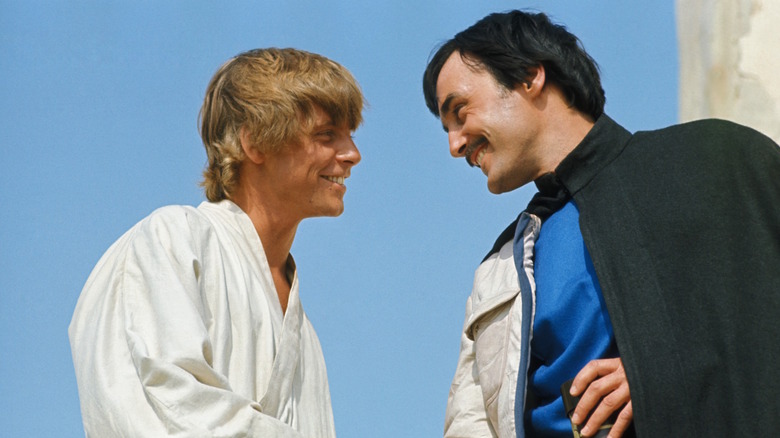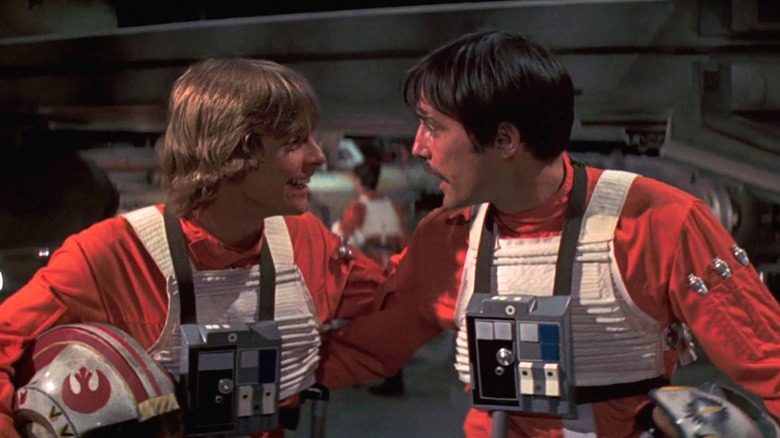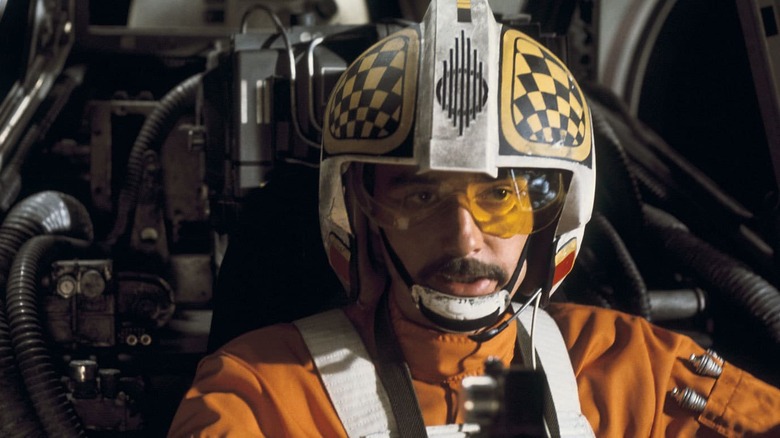The Deleted Star Wars Scene That Makes A New Hope's Ending Even More Emotional
The final moments of the Battle of Yavin 4 at the end of "Star Wars" are some of the most spectacular and tense minutes in movie history. Luke Skywalker — daydreaming farm boy from Tatooine turned Rebellion pilot — is seen maneuvering his X-Wing within the narrow trenches that cover the surface of the Death Star in a desperate attempt to destroy the station. Failure means the destruction of Yavin 4 and everyone on the planet, which includes what's left of the Rebel Alliance. It's an incredibly high-stakes and emotional moment that's critical not only to Luke's character but to the entire Star Wars trilogy.
But in an appearance on Joe and Anthony Russo's interview show "Pizza Film School," Mark Hamill elaborated on a deleted scene that amplifies the film's stirring ending. It's this scene, which occurs early in the film, that helps reveal exactly what inspires Luke to make that one-in-a-million shot that leads to the Death Star's destruction. We know what you're going to say, "It was Obi-Wan Kenobi!" And you're right, but in light of this deleted scene, it's clear that it wasn't just the Jedi Master's now-famous pep-talk that helped rouse Luke to victory.
Luke's B.F.F. Biggs Darklighter
In the original cut of "Star Wars," all audiences see of Luke's childhood friend Biggs Darklighter comes in the form of a few short scenes near the end of the film. But Biggs once had a much larger role to play in the story. In one deleted scene, Luke runs into him by accident while picking up those power converters from Tosche Station. Biggs actor Garrick Hagon elaborated on the scene in a quote obtained by Empire back in 2005:
"Having left [Tosche] Station, Luke and Biggs go out and talk about the Force and I advise him that there's a cause that we have to fight for. It's a scene that has some poignance because Luke can't go with me, he has to go back and work on his uncle's farm. The way the film is now, Luke doesn't have as much of a family connection or quite the same path. But it's quite a talky scene which I suppose doesn't really belong in an action picture."
But all that talk reveals quite a bit about the formative bond between the two kids from Tatooine. It also explains how Biggs found the Rebel Alliance, as he confides in Luke that he plans to jump ship to avoid being drafted into the Empire. Perhaps more importantly it underscores the fact that Luke's dream of joining the Rebellion originated from his friendship with Biggs. This makes their later meeting before the battle on Yavin 4 all the more fateful — and heartbreaking — as Biggs's first flight with Luke is also doomed to be his last.
The Loss of Biggs Spurs Luke's Reliance on the Force
"Star Wars" without this scene starts to feel somewhat lacking; at least, in regards to an important aspect of Luke's growth as a character. While speaking to the Russo brothers, Hamill elaborated on the effect the deleted conversation between Luke and Biggs also had on the film's ending — as well as one of the trilogy's most iconic moments.
"In the final assault on the Death Star, we're getting picked off left and right ... but the thing that motivates me to turn off the targeting device, and rely completely on the Force, is the death of Biggs Darklighter. You see me bump into him just before we go out ... That's what gets Luke to turn off the targeting device, when he loses his best friend. It was later that they decided to dub in Obi-Wan's voice saying 'Luke, use the Force,' and that's when he decides."
At this point in his story Luke has lost everyone he's considered family to the Empire, from his uncle and aunt, to Obi-Wan. When Biggs dies — blown away by Vader, which he later learns is his father — Luke finds himself completely alone, having lost another mentor-like figure. Yet at such a moment of utter loss and anguish he does the exact opposite of giving into fear. Rallying his faith in the Force to pull an unimaginable victory from the jaws of defeat, he's motivated not by Obi-Wan's words but the loss of Biggs. The deleted scene rightly places greater emphasis on the weight of his death and its galvanizing affect on Luke. Ultimately the scene results in an emotional reunion between the two in the film's final act and creates a far more fulfilling arc for both Hamill and Hagon's characters.


